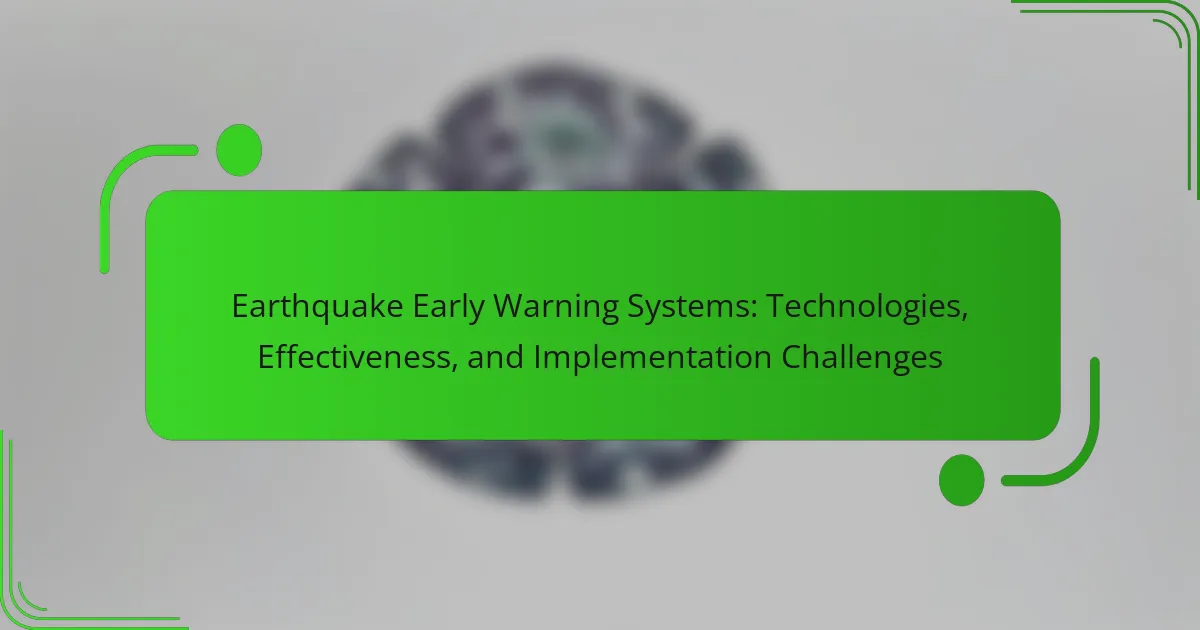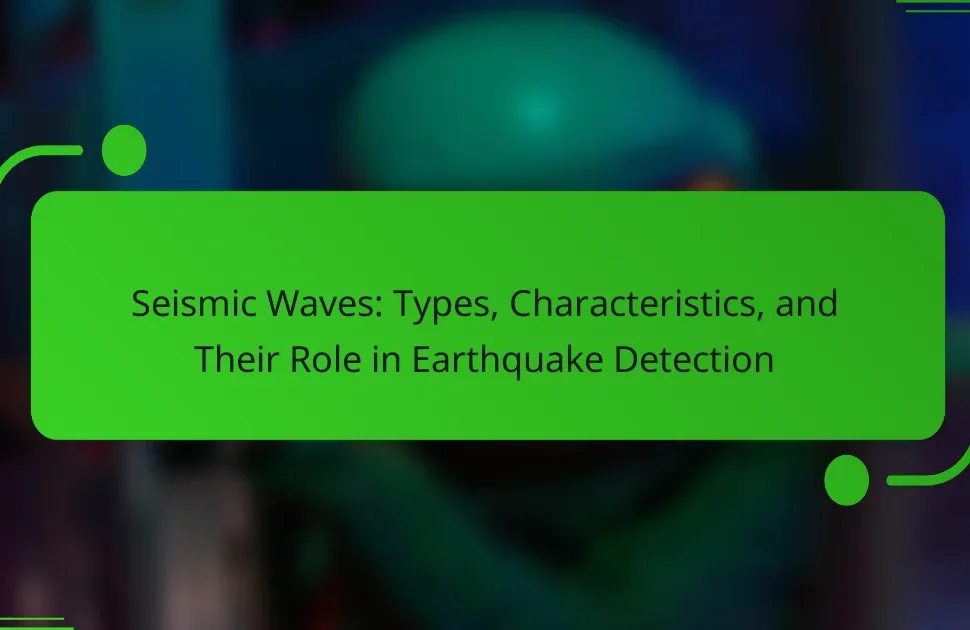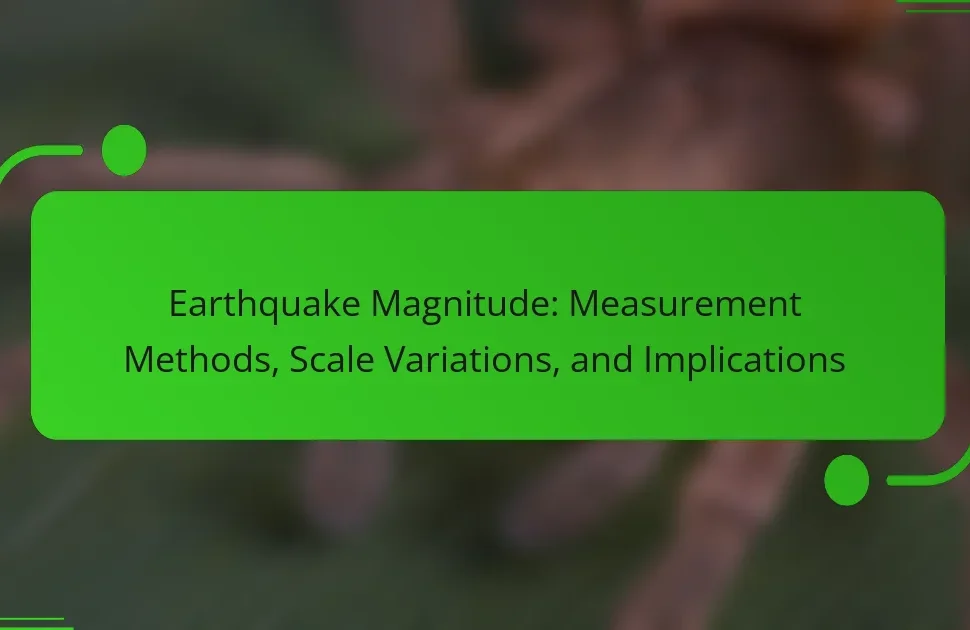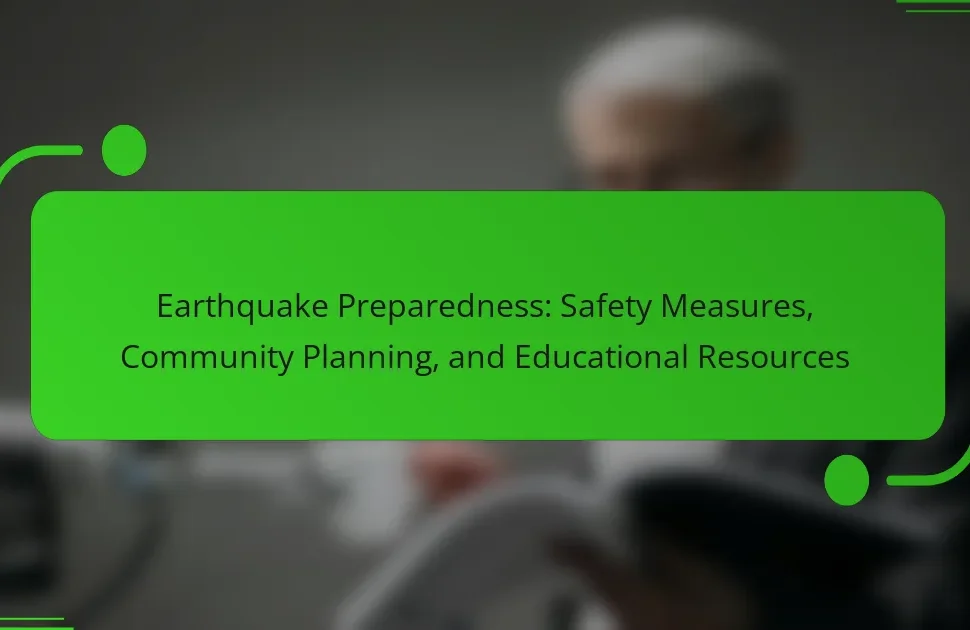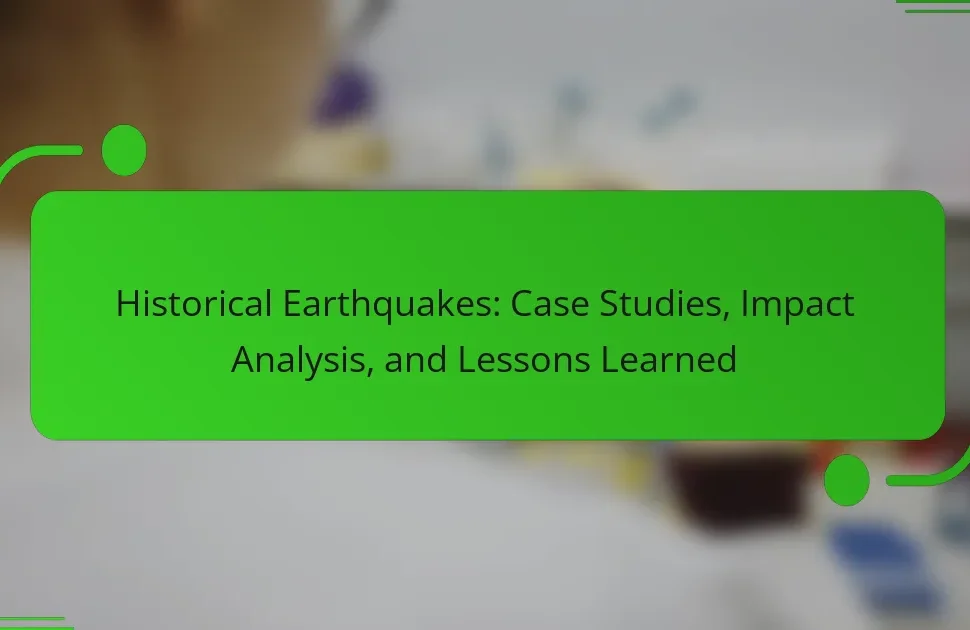Earthquake Early Warning Systems are advanced technologies that detect seismic activity and provide alerts before shaking occurs, allowing people and organizations to take protective measures. These systems rely on a network of sensors to monitor ground motion and analyze seismic waves, with the potential to save lives and reduce injuries during earthquakes. However, challenges such as rapid data processing, detection accuracy, and public preparedness must be addressed to enhance their effectiveness. Improvements can be made through increased sensor density, advanced data processing algorithms, and public education on response protocols, ensuring a more reliable and efficient warning system. Countries like Japan and Mexico serve as examples of successful implementation, highlighting the importance of overcoming these challenges.
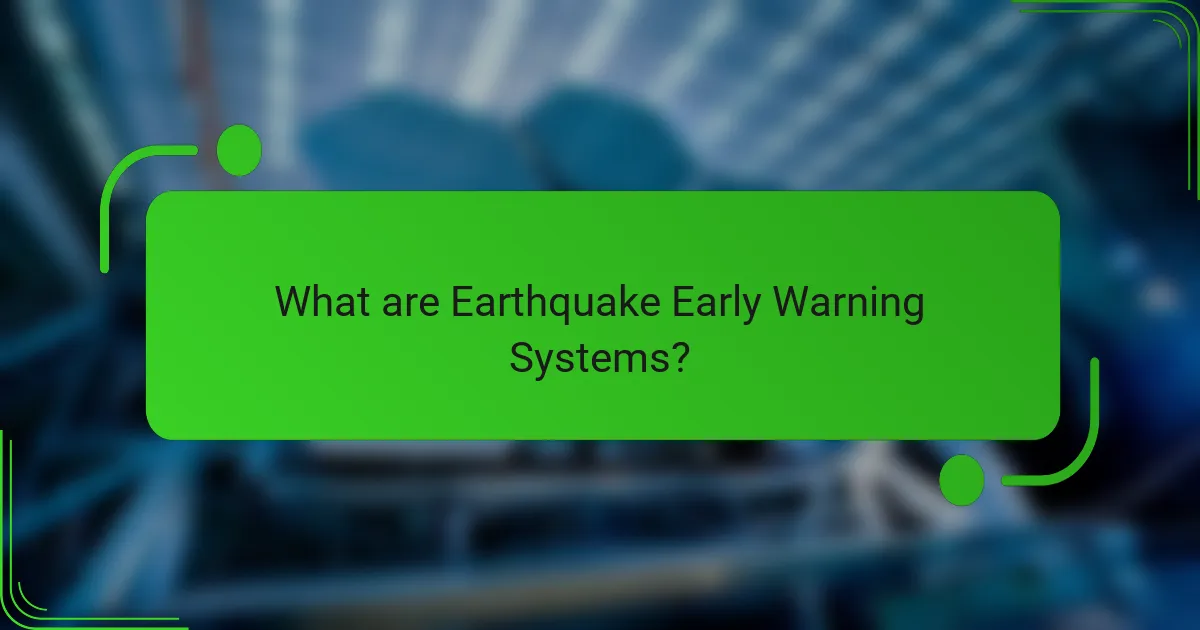
What are Earthquake Early Warning Systems?
Earthquake Early Warning Systems are technologies designed to detect seismic activity before it reaches populated areas. They utilize a network of sensors to monitor ground motion and analyze seismic waves. When an earthquake is detected, these systems can send alerts seconds to minutes before shaking occurs. This early warning allows individuals and organizations to take protective actions. For example, people can seek shelter, and automated systems can halt trains or shut down gas lines. Studies show that effective warning systems can reduce injuries and save lives during earthquakes. Countries like Japan and Mexico have successfully implemented such systems, demonstrating their effectiveness in real-world scenarios.
How do Earthquake Early Warning Systems function?
Earthquake Early Warning Systems function by detecting seismic activity and sending alerts before shaking reaches populated areas. These systems use a network of seismic sensors to monitor ground movements. When an earthquake occurs, the sensors quickly identify the initial seismic waves. These waves travel faster than the damaging waves that follow. The system calculates the earthquake’s location and magnitude in real-time. Alerts are then transmitted to the public and critical infrastructure. Studies show that timely alerts can provide seconds to minutes of warning. This can significantly reduce injuries and property damage.
What technologies are utilized in Earthquake Early Warning Systems?
Earthquake Early Warning Systems utilize several key technologies. Seismic sensors detect ground motion and measure earthquake waves. These sensors are often placed in various locations to provide real-time data. Communication networks transmit information rapidly to alert populations. Algorithms analyze seismic data to predict the earthquake’s impact. Some systems also integrate satellite technology for enhanced monitoring. Data processing centers compile and interpret information from sensors. Mobile applications deliver alerts to users on their devices. These technologies collectively enhance the effectiveness of early warning systems.
How is data collected and processed in these systems?
Data in earthquake early warning systems is collected through a network of seismic sensors. These sensors detect ground motion and seismic waves generated by earthquakes. Once data is captured, it is transmitted to a central processing unit. The processing unit analyzes the data in real-time to determine the earthquake’s location, magnitude, and expected impact. Algorithms are used to assess the data quickly and accurately. This information is then disseminated to alert systems and users. Studies show that timely alerts can significantly reduce injury and damage. For instance, the ShakeAlert system in California has demonstrated effectiveness in providing early warnings.
What are the key components of Earthquake Early Warning Systems?
The key components of Earthquake Early Warning Systems (EEWS) include seismic sensors, data processing algorithms, and communication networks. Seismic sensors detect ground motion and measure seismic waves. Data processing algorithms analyze the incoming data to estimate the earthquake’s location, magnitude, and expected impact. Communication networks transmit alerts to the public and critical infrastructure. These components work together to provide timely warnings before shaking reaches populated areas. Studies show that effective EEWS can reduce casualties and damage by providing seconds to minutes of advance notice.
What role do seismic sensors play in these systems?
Seismic sensors are critical components of earthquake early warning systems. They detect ground motion and vibrations caused by seismic waves. These sensors provide real-time data on the intensity and location of earthquakes. This information enables timely alerts to be sent to individuals and infrastructure. The alerts can help mitigate damage and save lives by allowing people to take protective actions. Studies show that rapid detection can significantly reduce injuries during seismic events. For example, the ShakeAlert system in California utilizes seismic sensors to provide warnings seconds before shaking reaches populated areas.
How do communication networks support Earthquake Early Warning Systems?
Communication networks are essential for Earthquake Early Warning Systems (EEWS). They facilitate the rapid transmission of seismic data from sensors to decision-making centers. These networks ensure timely alerts are sent to the public and emergency services. For instance, a robust communication infrastructure can reduce alert delivery time to seconds. This rapid communication can significantly enhance public safety. Studies show that timely warnings can reduce injuries and fatalities during earthquakes. Effective communication networks also support the integration of various data sources, improving the accuracy of early warnings. Overall, communication networks are critical for the effectiveness of EEWS.
What are the benefits of implementing Earthquake Early Warning Systems?
Implementing Earthquake Early Warning Systems (EEWS) provides critical benefits for public safety and disaster preparedness. These systems can detect seismic activity and provide alerts seconds to minutes before shaking occurs. This advance warning allows individuals to take protective actions, such as dropping to the ground or seeking shelter.
Research indicates that EEWS can significantly reduce injuries and fatalities during earthquakes. For instance, the 2011 Tōhoku earthquake in Japan demonstrated that early warnings saved lives by allowing people to evacuate buildings and halt trains.
Additionally, EEWS can minimize economic losses by giving businesses time to secure assets and prepare for disruptions. According to the United Nations, effective early warning systems can reduce economic losses by up to 30%.
Overall, the implementation of EEWS enhances community resilience and preparedness for seismic events.
How do these systems enhance public safety during earthquakes?
Earthquake Early Warning Systems enhance public safety by providing timely alerts before seismic shaking occurs. These systems detect initial seismic waves, known as P-waves, which travel faster than damaging waves. Alerts can be sent to individuals and infrastructure within seconds of detection. This advance warning allows people to take protective actions, such as “Drop, Cover, and Hold On.” Additionally, critical infrastructure can automatically shut down, reducing the risk of fires and other hazards. Studies show that these systems can reduce injuries and fatalities significantly. For instance, the 2011 Japan earthquake warning system reportedly saved thousands of lives by providing crucial seconds of warning.
What economic advantages can result from effective early warning?
Effective early warning systems can significantly reduce economic losses during earthquakes. By providing timely alerts, these systems allow individuals and businesses to take protective actions. This can minimize damage to infrastructure and property. Studies show that every dollar spent on early warning can save up to ten dollars in disaster recovery costs. Additionally, early warnings can prevent injuries and fatalities, reducing medical expenses and economic disruption. The overall economic resilience of communities improves with effective early warning systems in place.
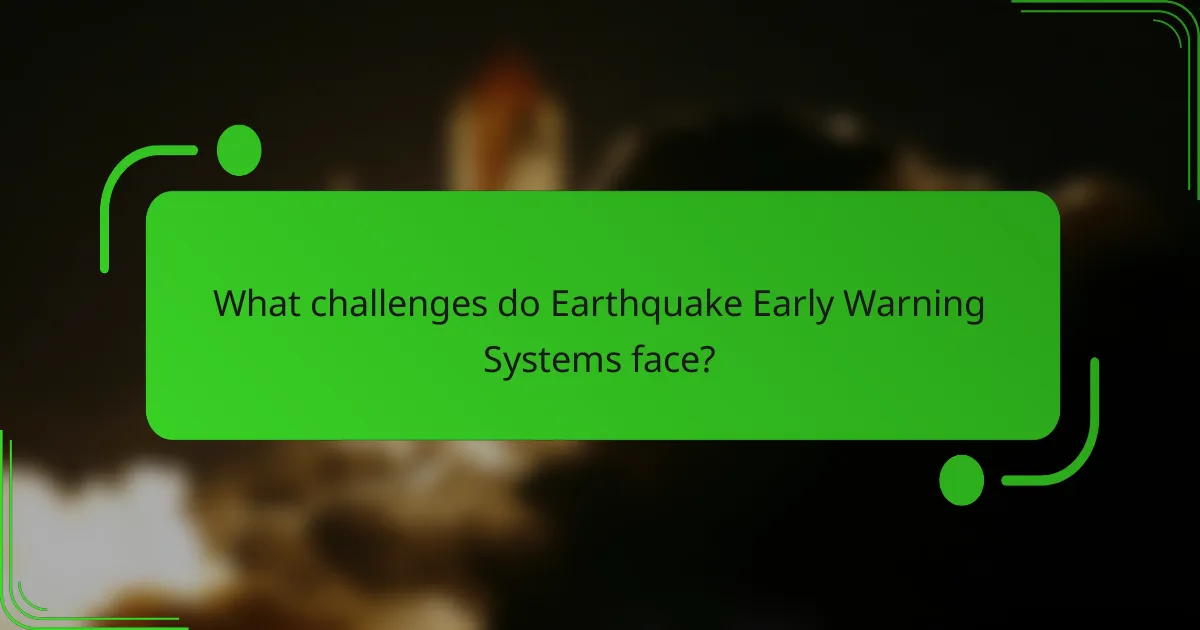
What challenges do Earthquake Early Warning Systems face?
Earthquake Early Warning Systems face several significant challenges. One major challenge is the need for rapid data processing. Systems must analyze seismic data within seconds to provide timely alerts. Another challenge is the accuracy of detection. False positives can lead to unnecessary panic and disruption. Additionally, coverage limitations can hinder effectiveness. Areas without sufficient sensor networks may not receive alerts. Public awareness and preparedness are also critical challenges. Many individuals may not understand the alerts or know how to respond. Lastly, funding and resources can restrict system development and maintenance. These challenges must be addressed to enhance the reliability and effectiveness of Earthquake Early Warning Systems.
What technical limitations affect Earthquake Early Warning Systems?
Earthquake Early Warning Systems face several technical limitations. One major limitation is the reliance on seismic networks, which may have gaps in coverage. Inadequate sensor density can lead to delayed detection of seismic events. Another limitation is the computational speed required for real-time data processing. Systems must analyze data quickly to provide timely alerts. Additionally, false alarms can occur due to sensitivity settings, leading to public distrust. Signal transmission delays can also hinder the effectiveness of alerts. Finally, the variability of earthquake characteristics complicates accurate predictions. These factors collectively impact the reliability and effectiveness of Earthquake Early Warning Systems.
How do false alarms impact public trust in these systems?
False alarms significantly undermine public trust in earthquake early warning systems. When these systems issue alerts that do not correspond to actual seismic events, the public may perceive them as unreliable. This perception can lead to skepticism regarding the effectiveness of the technology. Research indicates that repeated false alarms can cause individuals to ignore future alerts. For instance, a study by the US Geological Survey found that a high rate of false alarms can decrease the likelihood of people taking protective actions during real earthquakes. Trust in these systems is crucial for effective public safety responses. Without trust, the overall effectiveness of earthquake early warning systems diminishes.
What are the limitations of current seismic detection technologies?
Current seismic detection technologies face several limitations. They often have difficulties in accurately detecting low-magnitude earthquakes. This results in missed events that could be significant. Additionally, existing systems may not provide real-time data. Delays in data processing can hinder timely alerts. Environmental factors can also interfere with seismic signals. Urban noise and geological variations complicate detection accuracy. Furthermore, some technologies require dense sensor networks for effective monitoring. This can be costly and logistically challenging. Lastly, many systems lack interoperability. Different technologies may not communicate effectively, leading to gaps in information sharing.
What social and political challenges exist for Earthquake Early Warning Systems?
Social and political challenges for Earthquake Early Warning Systems include public trust issues and funding constraints. Many communities lack confidence in the reliability of these systems. This skepticism can reduce the effectiveness of alerts. Political support is often necessary for funding and resource allocation. Some regions may prioritize other emergency services over earthquake preparedness. Additionally, there can be disparities in access to technology. Vulnerable populations may not receive timely alerts. Political will is required to implement widespread education on the systems. Without it, the benefits of the technology may not be fully realized.
How does public awareness influence the effectiveness of these systems?
Public awareness significantly enhances the effectiveness of earthquake early warning systems. When the public is informed about these systems, they are more likely to respond appropriately during alerts. Studies show that informed individuals can evacuate or take cover more swiftly, reducing injury and fatalities. For example, the 2011 Japan earthquake demonstrated that public knowledge of warning systems led to quicker responses and saved lives. Increased awareness also fosters community engagement, leading to better preparedness and resilience. Overall, effective communication and education about these systems can maximize their intended benefits.
What role do government policies play in the implementation of these systems?
Government policies are crucial in the implementation of earthquake early warning systems. They provide the necessary framework and funding for development and deployment. Policies can dictate the standards for technology and data sharing among agencies. They also facilitate collaboration between local, state, and federal entities. Regulatory measures ensure that systems are effective and reliable. For instance, the California Early Warning System is supported by state legislation that mandates its operation. Funding from government grants has enabled the installation of sensors and infrastructure. Additionally, public awareness campaigns are often driven by government initiatives to educate citizens on the systems.
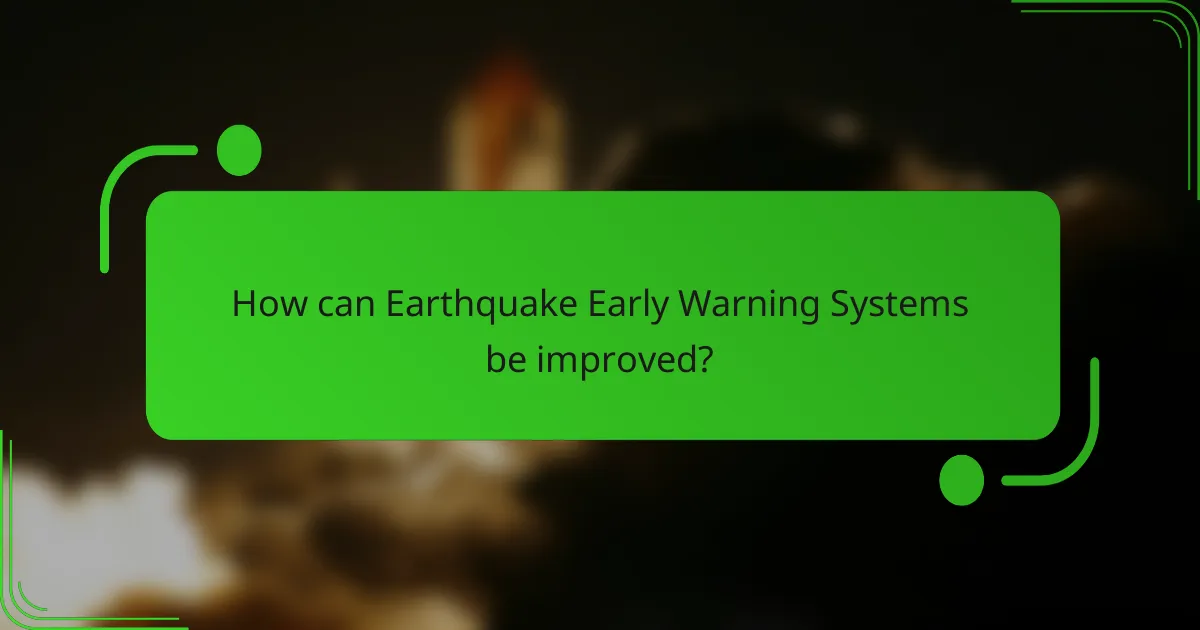
How can Earthquake Early Warning Systems be improved?
Earthquake Early Warning Systems can be improved by enhancing sensor networks and data processing algorithms. Increased sensor density allows for quicker and more accurate detection of seismic activity. Advanced algorithms can analyze seismic data in real-time, reducing false alarms. Integrating machine learning can further refine predictions based on historical data patterns. Collaboration among various agencies can improve data sharing and response coordination. Public education on system capabilities can increase community preparedness. Investments in infrastructure ensure system reliability during seismic events. Regular system testing and updates maintain operational effectiveness.
What advancements in technology could enhance Earthquake Early Warning Systems?
Advancements in technology that could enhance Earthquake Early Warning Systems include improved sensor networks, machine learning algorithms, and real-time data processing. Enhanced sensor networks increase the density and accuracy of seismic data collection. This allows for quicker detection of seismic events. Machine learning algorithms can analyze patterns in seismic data more efficiently. They can predict earthquake likelihood with higher accuracy. Real-time data processing enables immediate dissemination of alerts to the public. This reduces response time and potentially saves lives. Additionally, integration with mobile technology can ensure alerts reach a broader audience instantly. Studies show that these technologies can significantly improve response times and preparedness.
How can machine learning improve earthquake prediction accuracy?
Machine learning can improve earthquake prediction accuracy by analyzing vast datasets to identify patterns. These patterns may correlate with seismic activity, providing insights into potential earthquakes. Machine learning algorithms can process real-time data from seismic sensors more efficiently than traditional methods. For instance, a study by Zhang et al. (2020) demonstrated that machine learning models could predict aftershocks with over 80% accuracy. Additionally, machine learning can enhance the integration of geophysical data, leading to more precise models of tectonic movements. This integration allows for better forecasting and timely alerts, ultimately saving lives and reducing damage.
What innovations in sensor technology are on the horizon?
Innovations in sensor technology for earthquake early warning systems include advanced seismic sensors and artificial intelligence integration. These sensors are becoming more sensitive and capable of detecting smaller tremors. AI algorithms can analyze data in real-time, improving response times. New materials are being developed for sensors to enhance durability and accuracy. Wireless sensor networks are expanding coverage in remote areas. Miniaturized sensors are being deployed in various locations for better data collection. Enhanced data fusion techniques are improving the reliability of predictions. These advancements aim to increase the effectiveness and efficiency of earthquake early warning systems.
What best practices should be followed for effective implementation?
Effective implementation of Earthquake Early Warning Systems (EEWS) requires several best practices. First, stakeholder engagement is crucial. Involving local communities, government agencies, and scientists ensures a comprehensive approach. Second, robust technology integration is necessary. Utilizing advanced sensors and communication systems enhances detection and alert capabilities. Third, regular training and drills for emergency responders improve preparedness. Studies show that consistent practice leads to faster response times. Fourth, clear communication protocols must be established. Timely and accurate information helps mitigate panic during an earthquake. Lastly, continuous system evaluation and updates are essential. Regular assessments ensure the system adapts to new challenges and technologies. These practices collectively enhance the effectiveness of EEWS in saving lives and reducing damage.
How can community engagement improve the success of these systems?
Community engagement can significantly improve the success of earthquake early warning systems. Engaged communities are more likely to understand the importance of these systems. This understanding leads to higher adoption rates and compliance with safety protocols. Active participation fosters trust between the community and the authorities. Trust enhances communication during emergencies, ensuring timely dissemination of warnings. Studies show that communities involved in preparedness training respond more effectively during an earthquake. For example, research by the United Nations Office for Disaster Risk Reduction highlights that community-based initiatives lead to a 30% increase in effective response rates. Overall, community engagement creates a resilient environment that enhances the overall effectiveness of earthquake early warning systems.
What training is necessary for emergency responders to utilize these systems effectively?
Emergency responders require specialized training to utilize earthquake early warning systems effectively. This training includes understanding system operations and alerts. Responders must learn how to interpret warning messages accurately. Familiarity with the technology’s capabilities is essential for effective decision-making. Training should also cover the integration of alerts into existing emergency protocols. Regular drills and simulations enhance responders’ readiness. Knowledge of the local seismic landscape is crucial for context. Certification programs often provide structured training pathways for responders.
What are the future trends in Earthquake Early Warning Systems?
Future trends in Earthquake Early Warning Systems include enhanced sensor networks and improved data analytics. These advancements allow for quicker detection and more accurate alerts. Integration of machine learning algorithms is expected to refine predictive models. Real-time data sharing among agencies will enhance response coordination. Mobile applications will deliver alerts directly to users. Increased public awareness campaigns will educate communities on response protocols. The use of satellite technology will improve monitoring capabilities. Investment in infrastructure will support system resilience and reliability.
How might global collaboration shape the evolution of these systems?
Global collaboration can significantly enhance the evolution of earthquake early warning systems. By sharing data and research, countries can improve system accuracy and responsiveness. Collaborative efforts can lead to the development of standardized protocols. These protocols can facilitate better communication during seismic events. Joint investments in technology can accelerate innovation in detection and alert mechanisms. For instance, partnerships between nations have led to improved sensor networks. This results in quicker data analysis and dissemination. Furthermore, shared training programs can enhance the expertise of personnel involved. Collective knowledge can also drive policy changes that support system implementation.
What role will data sharing play in enhancing early warning capabilities?
Data sharing plays a critical role in enhancing early warning capabilities for earthquakes. It improves the accuracy and speed of detecting seismic events. When multiple data sources are integrated, the system can analyze real-time information more effectively. This integration allows for faster processing and dissemination of alerts. Collaboration between agencies and organizations enhances the reliability of the data. For example, the United States Geological Survey (USGS) collaborates with local agencies to share seismic data. Such partnerships have proven to reduce alert times significantly. Studies show that timely alerts can save lives and reduce economic losses during earthquakes. Data sharing ultimately strengthens the overall effectiveness of early warning systems.
Earthquake Early Warning Systems (EEWS) are advanced technologies that detect seismic activity and provide alerts before shaking affects populated areas. This article explores the functionality, key components, and technologies utilized in EEWS, highlighting their effectiveness in reducing injuries and economic losses during earthquakes. It also addresses the challenges these systems face, including technical limitations, public trust issues, and the need for effective communication and community engagement. Additionally, the article discusses future trends and best practices for improving the implementation and success of EEWS, emphasizing the importance of global collaboration and data sharing in enhancing early warning capabilities.
